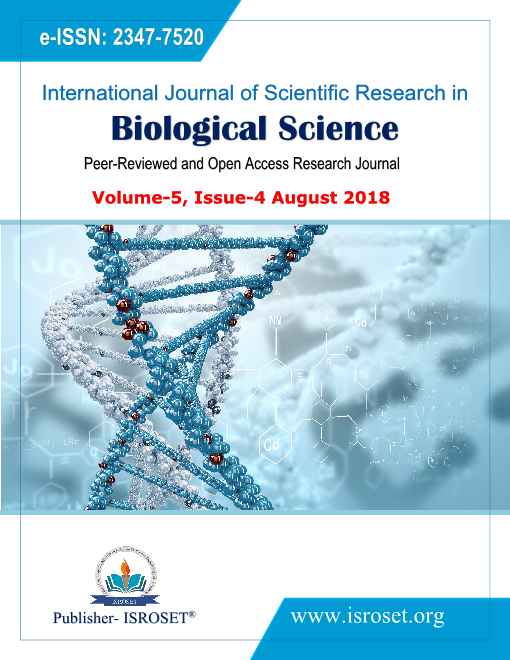General health status and morbidity pattern of bus drivers in West Bengal
Keywords:
Bus drivers, health status, occupational stress, Morbidity patternAbstract
Bus driving is a paradigm of highly strenuous occupation, with high risks of physical and mental ill-health. The drivers must respond to various unforeseen demands over which they have petite control. In driving time they are exposed to different types of hazards but there is dearth of data. This study was aimed at evaluating the general health status of the bus drivers, their demographic profile and morbidity pattern. Bus drivers (n= 254) were randomly taken from different bus depot and divided into two groups according to years of experience. Different type of physical, physiological and biochemical parameters were measured. Detailed job profile of bus drivers was also analyzed with the help of questionnaire. Jaundice, skin diseases, malaria were most prevalent among the two groups of bus drivers due to unhealthy and unhygienic environmental condition at workplaces. It was also observed that most of the bus drivers of two groups had one or multiple addictions and they take it in regular basis. They were compelled to work in different types of strenuous work, which may negatively affect their work capacity along with their physiological and psychological behavior also.
References
M.A.J. Kompier, V. Dimartino, “Review of bus drivers` occupational stress and stress prevention”, Stress Medicine, Vol. 11, pp. 253–262, 1995.
J.L.M. Tse, R. Flin, K. Mearns, “Bus driver well-being review: 50 years of research”, Transportation Research Part F: Traffic Psychology and Behaviour, Vol. 9, pp. 89-114, 2006.
M.A. Winkleby, D.R. Ragland, J.M. Fisher, S.L. Shyme, “Excess risk of sickness and disease in bus drivers: A review and synthesis of epidemiological studies”, Int J Epidemiol, Vol. 17, pp. 255-262. 1988.
S.R. Kartikeyan, B. Gurav, S.D. Joshi, W. Reshma, “Health and socio demographic profile of transport workers”, Ind J Occ Environ Med, Vol.8, pp. 8-10, 2004.
Z. Szubert, W. Sobala, “Health reasons for work disability among municipal transport drivers”, Med Pr, Vol. 56, pp. 285-93, 2005.
R.G. Villar, R.L. Shapiro, S. Busto, C. Riva-Posse, G. Verdejo, M.I. Farace, F. Rosetti, J.A. San Juan, C.M. Julia, J. Becher, S.E. Maslanka, D.L. Swerdlow, “Outbreak of type A botulism and development of a botulism surveillance and antitoxin release system in Argentina”, JAMA., Vol. 281, pp. 1334-1340, 1999.
P.O. Bylund, U. Björnstig, T.J. Lasson, “Occupational road trauma and permanent medical impairment”, Safety Science, Vol. 26, pp. 187-200, 1997.
L. Evans, “Traffic Safety and the Driver. New York”, Van Nostrand Reinhold, 1991.
M.S. Dev, “Government interventions and social security for Rural Labour in Empowering Rural Labour in India”, Radhakrishna and S.N. Sharma, (Eds), Institute for Human Development, New Delhi, 1998.
S.P. Gupta, “Globalization, Economic reforms and Employment Strategy in India”, Academic foundations, New Delhi, 2006.
R.V. Agnihotram, “An overview of occupational health research in India”, Indian J Occup Environ Med, Vol. 9, pp.4-10, 2005.
B. Ryan, C.M. Haslegrave, “Developing a verbal protocol method for collecting and analyzing reports of workers’ thoughts during manual handling tasks”, Appl Ergon, Vol. 38, pp. 805-819, 2007.
C.A. Burtis, E.R. Ashwood, D.E. Bruns, “Tietz fundamentals of clinical chemistry. 6th ed. St. Louis”, Saunders Elsevier; 2007. ISBN: 978-0-7216-3865-2.
M.A. Sinclair, “Questionnaire design”, Appl Ergon, Vol. 6, pp. 73-80, 1975.
D. Das, A. Das, “Statistics in Biology and Psychology, 4th edn”, Academic publishers, Calcutta, 2004.
WHO, “Waist Circumference and Waist–Hip Ratio: Report of a WHO Expert Consultation”, 8–11 December 2008, World Health Organisation, Geneva. 2011.
C.K. Pradhan, I. Chakraborty, S. Thakur, S. Mukherjee, “Physiological and Metabolic Status of Bus Drivers”, In ‘Ergonomics in Caring for People’, In the Proceedings of the 2015 International Conference on Humanizing Work and Work Environment, India, pp. 161-168, 2018.
S. Tiwari, J. Sikka, “Air Pollution Induced changes in foliar morphology of two tree species at Indore city”, Int. J. Sci. Res. in Biological Sciences, Vol. 2, Issue. 4, PP. 15-19, 2015.
Downloads
Published
How to Cite
Issue
Section
License

This work is licensed under a Creative Commons Attribution 4.0 International License.
Authors contributing to this journal agree to publish their articles under the Creative Commons Attribution 4.0 International License, allowing third parties to share their work (copy, distribute, transmit) and to adapt it, under the condition that the authors are given credit and that in the event of reuse or distribution, the terms of this license are made clear.







